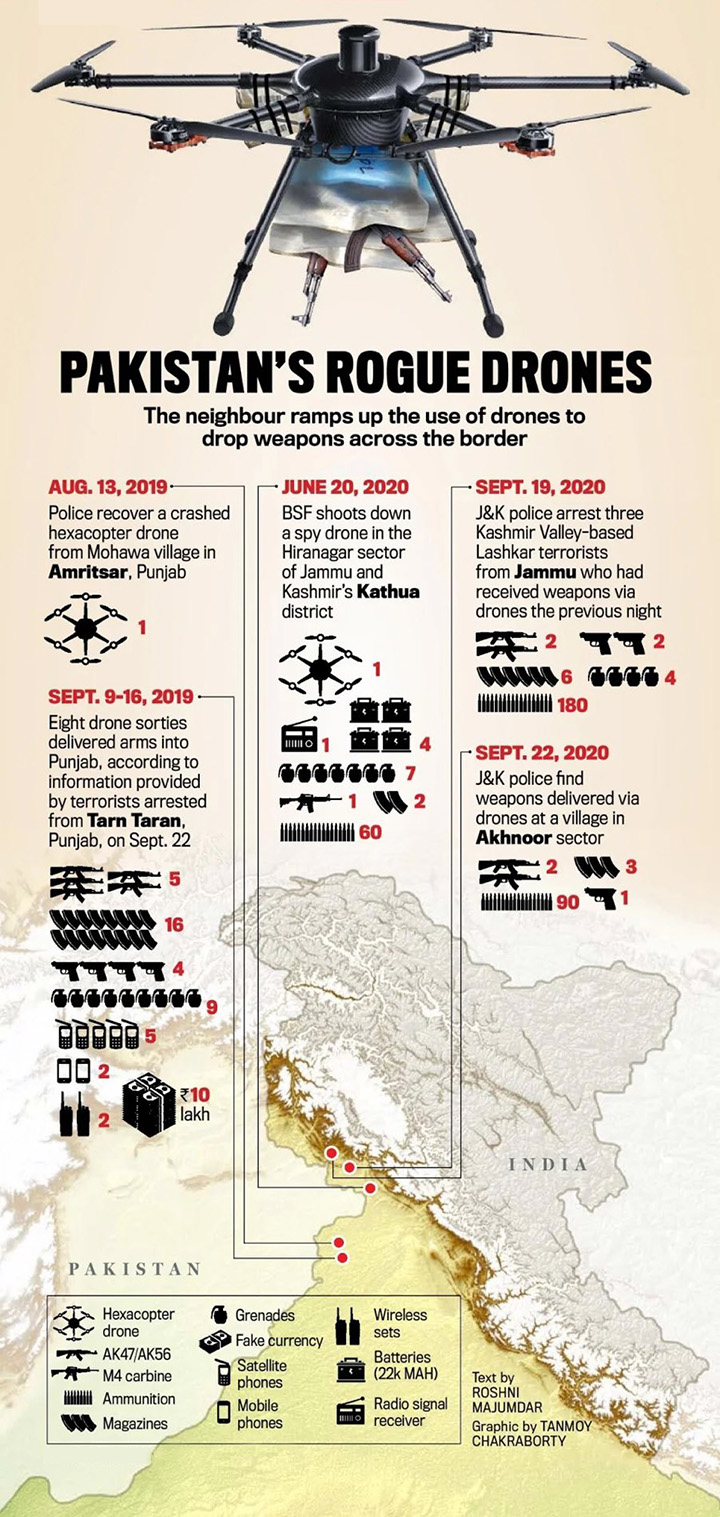Jammu Drone Attacks | 28 Jun 2021
Why in News
Recently, Drones were used for the first time to drop explosive devices, triggering blasts inside the Air Force Station’s technical area in Jammu.
Drone
- Drone is a layman terminology for Unmanned Aircraft (UA). There are three subsets of Unmanned Aircraft- Remotely Piloted Aircraft, Autonomous Aircraft and Model Aircraft.
- Remotely Piloted Aircraft consists of remote pilot station(s), the required command and control links and any other components, as specified in the type design.
- Besides combat use, drones are used for a range of purposes like package delivery, in agriculture (spraying pesticides etc), monitoring environmental changes, aerial photography, and during search and relief operations, among others.
Key Points
- Drone Attacks and Concerns:

- Over the past two years, drones have been deployed regularly by Pakistan-based outfits to smuggle arms, ammunition and drugs into Indian territory.
- Drones fly low and therefore cannot be detected by any radar system.
- According to government figures, 167 drone sightings were recorded along the border with Pakistan in 2019, and in 2020, there were 77 such sightings.
- With the rapid proliferation of drone technology and exponential growth of its global market in recent years, the possibility of a drone attack cannot be ruled out even in the safest cities in the world.
- Drones are becoming security threats particularly in conflict zones where non-state actors are active and have easy access to the technology.
- For example: 2019 twin drone attacks on Aramco crude oil production in Saudi Arabia.
- What makes combat drones in the hands of non-state actors most dangerous is the threat of them being used to deliver weapons of mass destruction.
- Weapons of mass destruction are weapons with the capacity to inflict death and destruction on such a massive scale and so indiscriminately that its very presence in the hands of a hostile power can be considered a grievous threat.
- In the military domain, small drones have been proliferating at a rate that has alarmed battlefield commanders and planners alike.
- In certain incidents, the small drones were also armed with explosive ordnance, to convert them into potentially lethal guided missiles, thus demonstrating the growing sophistication with which these potent warriors have found relevance in combat zones.
- Over the past two years, drones have been deployed regularly by Pakistan-based outfits to smuggle arms, ammunition and drugs into Indian territory.
- Reason for Increasing Drone Attacks:
- Cheap:
- The primary reason for this proliferation is that drones are relatively cheaper in comparison to conventional weapons and yet can achieve far more destructive results.
- Remotely Controlled:
- The biggest advantage that comes with using a drone for combat purposes is that it can be controlled from a remote distance and does not endanger any member of the attacking side.
- Easy to Operate:
- It is this easy-to-procure, easy-to-operate, and proven damage potential that makes it important for any country to equip its forces with anti-drone combat technology.
- Cheap:
- Rules for Drone Regulations in India:
- Unmanned Aircraft System (UAS) Rules, 2020:
- It is a set of rules notified by the government that aims to regulate the production, import, trade, ownership, establishment of the drone ports (airports for drones) and operation of UAS.
- It also seeks to create a framework for drones use by businesses.
- National Counter Rogue Drones Guidelines 2019:
- The guidelines had suggested a number of measures to counter rogue drones depending on the vitality of assets being protected.
- For places of critical national importance, the rules called for deployment of a model that consists of primary and passive detection means like radar, Radio Frequency (RF) detectors, electro-optical and infrared cameras.
- In addition to this, soft kill and hard kill measures like RF jammers, Global Positioning System (GPS) spoofers, lasers, and drone catching nets were also suggested to be installed.
- Unmanned Aircraft System (UAS) Rules, 2020:
- Other Initiatives:
- Directed-Energy Weapon:
- Defence Research and Development Organisation (DRDO) has developed two anti-drone Directed-Energy Weapon (DEW) systems, with a 10-kilowatt laser to engage aerial targets at 2-km range and a compact tripod-mounted one with a 2-kilowatt laser for a 1-km range. But they are yet to be productionized in large numbers.
- Smash-2000 Plus:
- The armed forces are now also importing a limited number of other systems like Israeli 'Smash-2000 Plus’ computerized fire control and electro-optic sights, which can be mounted on guns and rifles to tackle the threat from small hostile drones in both day and night conditions.
- Directed-Energy Weapon:
Way Forward
- In the backdrop of the drone attack, the Ministry of Civil Aviation could potentially look at making the existing regulations for unmanned aircraft systems more stringent.
- Current drone rules are sufficient to get information into the system about drones from the manufacturer or importer to end users. However, rogue drones will always be non-compliant. But yes, tightened regulations are required to create deterrence.
